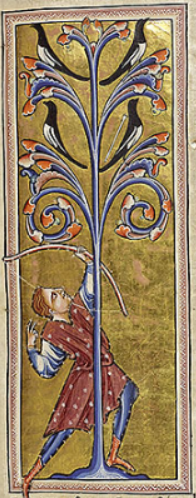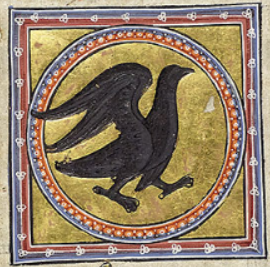Fables often warn by example, with an animal character’s mistakes leading to their death. Grievous errors, the morals further emphasize, can be avoided by a reader who learns from the fable’s message. The two medieval fables discussed below have no deaths within the narrative, only the threat of it. Both feature parent animals—a raven or crow in one, a doe in the other—teaching their children to be cautious of humans, and to pay close attention to their actions. These fables, in which the animal parents and their children have the ability to speak to one another, depict a means of learning to fear that is usually ascribed to humans only: verbal information. (Two other ways of learning fear, which have been studied in a number of species, are through direct conditioning and through observing the behavior of others; the latter is sometimes called “vicarious learning” or “social fear transmission.”)
The two fables in question appear one after the other, in two collections. One version is in a Latin prose collection in the “Romulus” tradition, called the Romulus Anglicus cunctis, edited by Léopold Hervieux from a fifteenth-century manuscript.[1] Another version is found in the Fables attributed to Marie de France.[2] The fable of The Raven and His Chicks, as found in Hervieux’s edition, is below, followed by my translation.
Corvus consedit in arbore quadam secus viam et cum eo Pulli sui. Sedens igitur Pullos quos habebat monebat attencius ut cauti essent. Deambulabat autem homo eadem via, et dixit Corvus ad pullos : Hic est ille, quem nos cavere maxime oportet, et vos, si videritis eum molinantem ad terram, fugite velociter. Cui unus Pullorum respondit : Eciam si se non inclinaverit, appropinquantem fugere volo. Bonum est, inquit pater, et de cetero per te non sollicitabor; sed alios Pullos meos, ut cauti sint, ammonebo.
A raven settled onto a certain tree beside a road, and with him his chicks. While he was sitting, he then carefully advised the chicks that he had, so that they would be cautious. Then a man came walking along the same road, and the raven said to his chicks: This is the one that we need to be the most careful about, and you, if you see him bending to the ground, flee quickly. To which one of the chicks responded: Even if he doesn’t bend over, I intend to flee when he approaches. Good, said the father, and I won’t otherwise worry for you. But my other chicks, I’ll warn them to be cautious.

The implication of the Romulus version of this fable, as I see it, is that it’s good to be on the safe side. While the father had used the example of a human bending over as something to be particularly watchful for, presumably because he could be picking up something to throw at the birds, one of his sons declares that he will flee at the man’s approach regardless, and it is this assertion which dispels his father’s worry for his future safety; it is yet to be seen whether his other offspring will be as cautious.
Marie’s version of The Raven and His Chicks, while it similarly portrays a parent teaching their young to fear humans, ultimately has a much different message about caution. The parent corvid in Marie’s version (a crow rather than a raven) specifies that his son ought to watch out for a man bending over to pick up a stick or a stone, and flee at the sight (lines 5–8).
“If I don’t see him bend over, and he doesn’t have anything in his hand, then do I need to move?” inquires the chick (Si jeo nel vei, fet il, beisser / n[e]’en ses meins rien manïer, / [me] dei jeo dunc[es] remüer, lines 9–11). At this point, the parent declares that he needn’t teach his son anything further, and that he is off to aid his other children. The implication is that the young crow is discerning when it comes to human actions and what they portend, and that he knows to be cautious, but not excessively so. And indeed, animals who regularly encounter human (or non-human) threats must strike a balance between their own safety and the need to find crucial resources such as food.
The raven fable, in the Romulus Anglicus cunctis, is left without a moral. In both the Romulus and Marie’s collection, the raven/crow fable is immediately preceded by the fable of The Hind Instructing Her Fawn. In this fable, a mother deer similarly warns her offspring to be wary of humans, such as the hunter they see nearby. However, rather than simply absorbing her advice, the son talks back, arguing that the hunter must in fact be afraid of them. After all, why else would he be sneaking around and hiding in the bushes? The mother reiterates that the man, and particularly the weapons he bears, are deadly. The moral, in the Romulus, is that “fools don’t foresee harms or dangers and don’t fear them, until they feel them” (Sic stulti dampna vel pericula non prevident nec pertimescunt, donec ea senciunt).[3] The naïve young fawn seems to represent such fools, whereas his wiser mother can more accurately read human behavior and identify threats.

Of course, in real life, a young bird or deer would learn fear from another animal’s sudden change in body language, or their alarm call, or even their scent, not from a verbal explanation. Humans, though, can learn through storytelling. Research in psychology has suggested that children readily learn to fear through verbal information—particularly when the information comes from an adult, rather than a peer.[4] Fables both show and tell, in a sense, when they combine memorable narratives about another’s ill-fated end (or prudent evasion of disaster) with explicit moralizations. These stories are not meant to be taken literally; after all, The Raven and His Chicks isn’t meant to teach young readers that they should run away at the sight of a man bending to the ground to pick up a rock. Rather, readers are prompted to extrapolate from the animal scenario and apply this to more abstruse, though no less real, dangers. Fables teach, perhaps, not simply what to fear, but how to fear. Fear can be life-saving, but excessive or unnecessary fear can prove maladaptive. As for what might constitute a maladaptive level of fear, the two versions of the raven/crow fable discussed above seem to draw the line in different places; the Romulus version advocates greater wariness than Marie’s version, which suggests that wisdom lies in knowing both when to flee and when not to.
Linnet HealdPhD in Medieval Studies
University of Notre Dame
[1] Léopold Hervieux, Les fabulistes latins depuis le siècle d’Auguste jusqu’à la fin du Moyen Âge, vol. 2 (Paris : Firmin-Didot, 1884), p. 612.
[2] Charles Brucker, ed., Marie de France: Les Fables, édition critique accompagnée d’une introduction, d’une traduction, de notes et d’un glossaire, 2nd ed. (Paris–Louvain: Peeters, 1998), pp. 334-7.
[3] Léopold Hervieux, Les fabulistes latins, vol. 2, p. 612.
[4] A. P. Field et al., “Who’s afraid of the big bad wolf: a prospective paradigm to test Rachman’s indirect pathways in children,” Behaviour Research and Therapy 39, 11 (2001): 1259-76. https://pubmed.ncbi.nlm.nih.gov/11686263/
